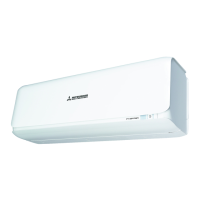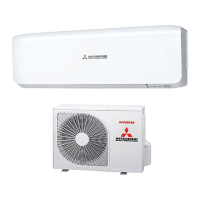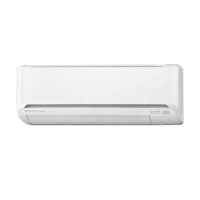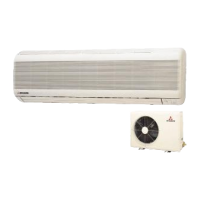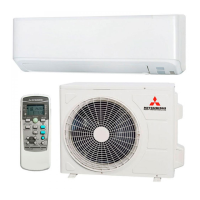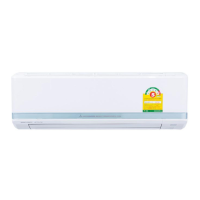Do you have a question about the Mitsubishi SRK20ZSXA-W and is the answer not in the manual?
| Type | Split System |
|---|---|
| Cooling Capacity | 2.0 kW |
| Heating Capacity | 2.7 kW |
| Refrigerant | R32 |
| Power Supply | 220-240 V, 50 Hz |
| Energy Efficiency Ratio (EER) | Not Available |
| Indoor Unit Dimensions (W x H x D) | 870 x 290 x 230 mm |
| Outdoor Unit Dimensions (W x H x D) | 840 x 540 x 350 mm |
| Indoor Unit Weight | 10 kg |
| Noise Level (Indoor) | 19 dB |
Explains the meaning of warning and caution symbols used in the manual for safety.
Highlights safety measures specific to R32 refrigerant, including flammability risks.
Covers warnings for domestic use and the necessity of qualified installer for safe installation.
Details risks associated with flammable gas leaks and requirements for proper earthing.
Addresses child safety, not inserting objects, and avoiding prolonged exposure to cooling air.
Covers precautions regarding fuses, wet hands, flammable substances, and water near the unit.
Safety tips for handling the unit, avoiding water contact, and operating without filters.
Emphasizes consulting a dealer for repairs and handling abnormal situations safely.
Advice on setting suitable room temperature, avoiding sunlight and draughts for efficiency.
Guidance on cleaning filters, adjusting airflow, using timers, and managing heat sources.
Identifies parts of the indoor unit, including air inlet, filters, fan, heat exchanger, and sensors.
Identifies parts of the outdoor unit, such as fan, heat exchanger, air outlet, and labels.
Explains the unit's display section, including ON/OFF, TIMER, and RUN lights.
Lists accessories provided with the air conditioner, such as remote control and filters.
Instructions for inserting batteries and identifying when they are exhausted.
Guidance on how to install the remote control holder on a wall or pillar.
Lists prohibited actions and warnings for handling the remote control safely.
Procedure to set up two air conditioners to be operated by a single remote control.
Instructions on how to activate the child lock to prevent accidental operation and how to release it.
Steps to adjust the left/right airflow range to maximize air-conditioning efficiency.
Diagrams and advice on how installation location affects airflow range settings.
Guides on how to turn the motion sensor to the right or left for optimal detection.
Details factors affecting motion sensor detection accuracy, such as room conditions and obstacles.
Explains the function of each button on the remote control for various operations.
Describes how signals are transmitted from the remote to the unit and the display feedback.
Step-by-step guide to set the current time and day of the week on the remote control.
Instructions on how to activate AUTO mode and how to stop it when desired.
Details on how to adjust the preset temperature during AUTO mode operation.
Explains how to set fan speed and the meaning of different levels like ULo, Lo, Me, Hi.
Guide to selecting and operating the unit in COOL, HEAT, DRY, and FAN modes.
Specifies the operational temperature ranges for COOL and HEAT modes to prevent device activation.
Explains heat pump operation, capacity reduction in cold, and the automatic defrost function.
Instructions for adjusting airflow direction using the remote control's U/D and L/R buttons.
Guide on how to enable and disable the 3D AUTO mode for efficient room air-conditioning.
Step-by-step instructions to set the sleep timer and how to cancel it.
Instructions for setting the off timer to stop the unit automatically and how to cancel it.
Guide to setting the on timer for automatic start and how to cancel the timer.
Instructions for using both Sleep Timer and On Timer simultaneously for combined scheduling.
Guide to setting both On Timer and Off Timer to create a dual schedule.
Instructions on how to start and stop the Allergen Clear operation for air purification.
Details on creating up to 4 programs per day for automated weekly operation.
Step-by-step guide to set specific programs for individual days of the week.
Procedure to cancel specific programs set for individual days within the weekly timer.
Instructions to cancel all programmed weekly timer settings at once.
Guide on how to review and confirm the programmed weekly timer settings.
How to use High Power mode for intensified cooling or heating for a limited time.
Instructions for activating ECO mode to save energy by suppressing operation power.
How to set the unit to maintain a comfortable temperature around 10°C during absence or night.
Instructions for activating Silent mode to reduce the outdoor unit's noise level.
Explains how to navigate the MENU switch to access various setting options.
Guide on how to adjust the brightness level of the remote control's display.
Instructions for setting the automatic shut-off timer based on room occupancy detection.
Guide on how to run the self-clean cycle to remove moisture and control mold growth.
Instructions on how to save preferred settings for future recall and operation.
Essential safety precautions and preparation steps before performing maintenance.
Step-by-step instructions for removing, cleaning, and reinstalling air filters.
Guidance on cleaning the main unit body and the air inlet panel.
Description of the air inlet panel's structure, including hooks and motor-driven operation.
Detailed instructions on how to safely remove the air inlet panel.
Detailed instructions on how to properly install the air inlet panel.
Steps to prepare the unit for storage at the end of the cooling/heating season.
Steps for preparing the unit for operation at the start of a new season.
Information on inspecting, cleaning, and replacing allergen and deodorizing filters.
Recommendations for ideal locations to install the unit for proper ventilation and function.
Advice on selecting installation locations to minimize noise and vibration impact.
Explanation of Demand Response Enabling Devices (DRED) standard and its supported modes.
Steps to check before contacting a dealer for issues like no operation or poor cooling/heating.
Explains airflow behavior during heating, cooling, and dry operations, including pauses and defrosting.
Provides explanations for common sounds like gurgling, cracking, hissing, and whistling.
Lists specific situations where immediate dealer contact is necessary for safety and repair.
Explains how the unit automatically resumes operation after a power interruption.
Guidance on operating multiple units simultaneously and managing mode conflicts.
Details error codes indicated by the RUN light flashes and their possible causes.
Details error codes indicated by the TIMER light flashes and their possible causes.
